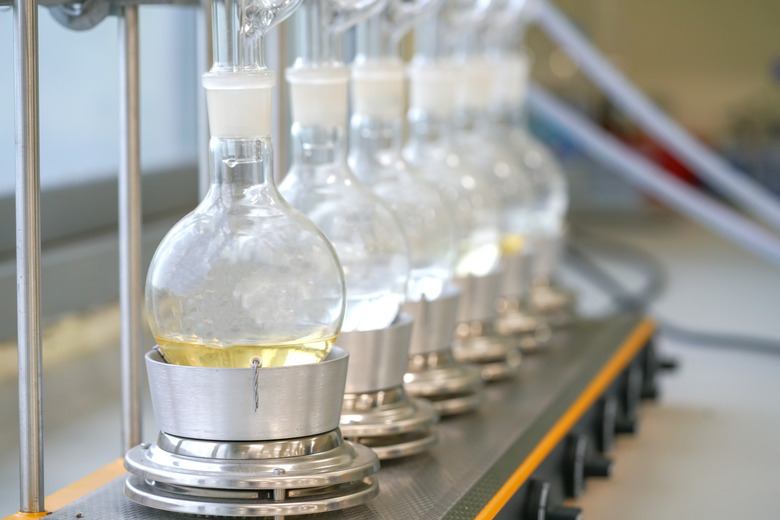Examples Of Evaporation And Distillation
Matter exists in solid, liquid and gaseous phases naturally, and it's possible to transition between the phases. Evaporation is the phase change from liquid to the gas state. It's constantly occurring in the environment. Unlike evaporation, distillation is not a naturally occurring process. However, phase changes from liquid to gas and back to liquid occur during distillation.
Evaporation Process
If molecules of a liquid gain enough energy in the form of heat from the environment, they turn into vapor. Evaporation occurs on the surface of a liquid, not throughout the whole body or volume. When evaporation occurs, the pressure of the vapor is lower than the pressure of the surrounding atmosphere. Condensation is the opposite of evaporation. It takes place when the temperature of the vapor cools, causing the vapor to condense back into liquid form.
Examples of Evaporation
Two familiar examples of evaporation are sweating and the rain cycle. When you are hot or undergo strenuous activity, your body produce sweat. The sweat on your skin gains energy from the body and eventually evaporates, in turn cooling you down. In weather, evaporation is demonstrated during the rain cycle. Water on earth's surface evaporates and travels up through the atmosphere, where it's cooler. The cooler temperatures cause the vapor to condense back into water droplets, which come together to form clouds. When the cloud becomes saturated, the droplets fall to the ground as rain.
Distillation Process
Distillation is a controlled process commonly used in chemistry to separate mixtures of liquids. The process includes boiling a liquid and then collecting the vapor as it cools and condenses back into liquid form. Boiling is similar to evaporation because both processes turn a liquid into a gas. However, when a liquid is boiled, the molecules gain more energy and the vapor pressure is more than the atmospheric pressure. Because of the pressure difference, gas bubbles from all through the liquid are able to rise up and escape as vapor. Different compounds have different boiling points, so in a liquid mixture, the compounds with lower boiling points evaporate first.
Examples of Distillation
Aside from being used in the chemistry lab, distillation is used for many other commercial processes. Salt water is turned into fresh water through distillation. Various forms of fuel, such as gasoline, are separated from crude oil by distillation. Alcoholic beverages are made through distillation. The alcohol is boiled off from the rest of the mixture and collected in a concentrated format.
References
- Georgia State University: Saturated Vapor Pressure
- Georgia State University: Perspiration Cooling of Body
- University of Colorado: Distillation
- U.S. Geological Survey: The Water Cycle
- U.S. Geological Survey: Saline Water: Desalination
- The Engineering Toolbox: Boiling Points of Some Common Fluids and Gases
Cite This Article
MLA
Malesky, Mallory. "Examples Of Evaporation And Distillation" sciencing.com, https://www.sciencing.com/examples-evaporation-distillation-23412/. 16 April 2018.
APA
Malesky, Mallory. (2018, April 16). Examples Of Evaporation And Distillation. sciencing.com. Retrieved from https://www.sciencing.com/examples-evaporation-distillation-23412/
Chicago
Malesky, Mallory. Examples Of Evaporation And Distillation last modified March 24, 2022. https://www.sciencing.com/examples-evaporation-distillation-23412/
